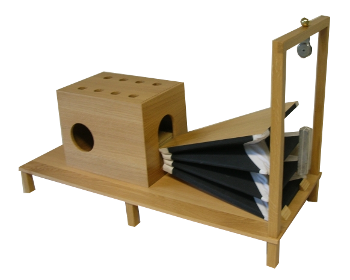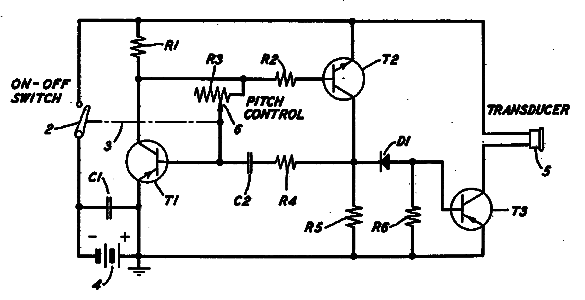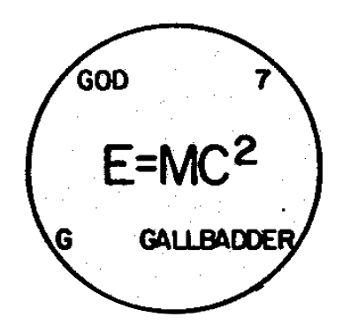Bruce Baker and Minspeak
June 22, 2020
Children have always enjoyed
toys that
talk. The
electronic talking toys of today are far in advance of the
mechanical talking toys of my childhood, but the mechanical toys were still fun. I remember one
pullstring toy that a younger
brother of mine had. Pulling a string powered an internal
mechanism like a
gramophone to give
phrases like "The
cow goes, Moo," in which the
Moo sound was an actual cow's mooing. The toy was much more fun when I discovered that
sharply striking the toy after the word, "goes," produced a different
animal sound; e.g., "The cow goes, Quack-Quack-Quack."
As I wrote in a
recent article (A Voice from the Crypt, March 16, 2020),
Charles Wheatstone (1802-1875),
Inventor of the
eponymous Wheatstone bridge, produced a
bellows-operated "speaking machine" in 1837 that included a
vocal tract, and also a
tongue and
lips. This was an enhanced version of the
Wolfgang von Kempelen's speaking machine developed in the period 1770-1790.
Kempelen is more famous for his
mechanical Turk, a supposed
chess-playing automaton that was actually a
hoax.

A reproduction of Wolfgang von Kempelen's speaking machine.
The bellows was activated by a weight attached through a pulley, a mechanism that's just barely visible in this image.
(Wikimedia Commons image by Fabian Brackhane)
Kempelen strived to
simulate the complete
physiology of the vocal tract by using a bellows as the
lungs, a
reed as the
vocal cords, a simulated
mouth, and a simulated
throat and
nasal cavity. One mouth assembly consisted of a
wooden box with
hinged shutters that acted as
lips. Kempelen's speaking machine was capable of speaking recognizable phrases. Such speaking devices in which the
mechanism of human speech is
emulated perform what's now called
articulatory synthesis.
An interesting variation of articulatory synthesis is to use parts of the human vocal physiology to create a unique manner of
musical speech with a
talk box. A typical talk box has a
plastic tube that directs
amplified sound from a
musical instrument into the
musician's mouth. The musician can then
vocalize the instrument, and this vocalization is captured by the same
microphone used to record
singing. The talk box is typically used with an
electric guitar, since the rich
harmonic content of that instrument produces quality vocalizations. A good example of a talk box is in
Peter Frampton's, "
Do You Feel Like We Do."[1]
People who have had a
laryngectomy have been able to speak again using a device called an
electrolarynx. This device offers a substitute for the vocal cords to provide an audio excitation source for the
pharyngeal cavity. The
invention of the
transistor allowed
Bell Labs researchers to create a compact device for this purpose in 1959, as shown in the figure.[2-3]

Figure two from US Patent No. 3,072,745, "Unitary artificial larynx," by Harold L Barney, January 8, 1963. This circuit is a simple two transistor relaxation oscillator driving a one transistor class-D amplifier. The patent describes "An artificial larynx comprising, in combination, a pulse circuit for producing a train of pulses in the frequency range of approximately to 200 pulses per second, with a pulse duty factor of approximately five percent, an electroacoustic transducer responsive to said pulses for introducing a tone into the pharynx of the user..." (Via Google Patents.[3])
As the example of
Stephen Hawking (1942-2018) shows, people with
amyotrophic lateral sclerosis (ALS, commonly known as
Lou Gehrig's disease, named after the
celebrity baseball player of the
New York Yankees who succumbed to it), are able to
communicate effectively using a modern
technology called
augmentative and alternative communication (AAC). Developers of this technology have their own
scientific journal,
Augmentative and Alternative Communication. Hawking and such technology have been instilled in
popular culture by
television appearances of Hawking and his
speech-generating device, notably in
Star Trek: The Next Generation,
The Big Bang Theory, and
The Simpsons.
One of the pioneers of speech-generating devices,
Bruce Baker (1943-2020), died on May 7, 2020, at age of 77. Baker created
Minspeak™, which is likely the most widely used system for augmentative and alternative communication.[5] Although Minspeak™ is implemented by
computer, Baker was not a
computer scientist; rather, he was a
linguist who was influenced by his knowledge of
hieroglyphic languages to craft this particular system.[4] This approach was a significant departure from the word-based
user interface for such devices in the
1980s.[5]

Middle Egyptian hieroglyphs for the adjective "sweet" (left) and the symbol for "elder" (right). Sweet is rendered as a spelling of the word, "bnrj," while "elder" is represented by a symbol that looks like an old man. (Created using Inkscape from the unicode symbols U+130C0, U+13216, U+1308B, U+131CB, U+131DC, and U+13017.)
Baker devised Minspeak™ while working on a
Ph.D. degree in
linguistics at the
Middlebury Language Center (Middlebury, Vermont) with a background in
Greek and
Latin.[5] He interviewed people with
disabilities in searching for a
dissertation topic, and he discovered that the AAC systems of that time were linguistically primitive.[5] He saw that such systems did not take advantage of the
artificial intelligence techniques being used for
language translation. The user interface for such systems were more like a
typewriter, and they were difficult to use.[5] Baker's Minspeak™ system used hieroglyphics, rather than an
alphabet, and the
icons of his system could be sequenced in ways that simplified the expression of complex ideas.[4]
The first version of the Minspeak™ system, which had about 40 icons arrayed on a
keyboard, was programmed by one of Baker's former
studentss, Kenneth Smith, a
mathematician and
computer programmer. Minspeak™ was implemented on an
AIM-65 computer with a
Votrax SC01 voice synthesizer (The AIM 65 was my first
laboratory computer, used to
automate a
liquid phase epitaxy system programmed using
FORTH).[5] It was presented at a 1983
meeting of the
American Speech-Language-Hearing Association.[5] After so many
decades, Minspeak™ is still a
commercial success, with a website at
minspeak.com.

A strange juxtaposition - God and gallbladder.
A portion of figure two from US Patent No. 4,661,916, "System for method for producing synthetic plural word messages," by Bruce R. Baker, Richard D. Creech, and Kenneth W. Smith, April 28, 1987.[6]
In that era without touch screens, actual keys were used, encoded with "... an alphabetical letter... a portion of the human anatomy and a proper name."
(Via Google Patents.[6])
References:
- Peter Frampton, "Do You Feel Like We Do," YouTube Video, July 31, 2018. The talk box effect starts at 7:25.
- H. L. Barney, F. E. Haworth, and H. K. Dunn, "An experimental transistorized artificial larynx," The Bell System Technical Journal, vol. 38, no. 6 (November, 1959), pp. 1337-1356, DOI: 10.1002/j.1538-7305.1959.tb01591.x.
- Harold L Barney, "Unitary artificial larynx" US Patent No. 3,072,745, January 8, 1963.
- Linnea Crowther, "Bruce Baker (1943-2020), invented Minspeak for nonverbal people's AAC speech devices, Legacy.com, May 7, 2020.
- Bruce R. Baker, "Minspeak™ History," Spring 1988, Minspeak™ Website.
- Bruce R. Baker, Richard D. Creech, and Kenneth W. Smith, "System for method for producing synthetic plural word messages," US Patent no. 4,661,916, April 28, 1987.
- Minspeak™ Website.
Linked Keywords: Child; children; toy; speech; talk; electronic; mechanical system; pullstring; brother; mechanism (engineering); phonograph; gramophone; phrase; cattle; cow; sound; impact (mechanics); animal; Charles Wheatstone (1802-1875); inventor; eponym; eponymous; Wheatstone bridge; bellows; vocal tract; tongue; lips; Wolfgang von Kempelen's speaking machine; Wolfgang von Kempelen; The Turk; mechanical Turk; chess; automaton; hoax; reproduction; pulley; Wikimedia Commons; simulation; simulate; physiology; lungs; reed (mouthpiece); vocal cords; mouth; throat; nasal cavity; wood; wooden; box; hinge; shutter; mechanism (biology); imitation; emulate; articulatory synthesis; music; musical; talk box; plastic; tube (fluid conveyance); amplifier; amplify; musical instrument; musician; vocalize; microphone; singing; electric guitar; harmonic; Peter Frampton; Do You Feel Like We Do; laryngectomy; electrolarynx; pharyngeal cavity; invention; transistor; Bell Labs; research; researcher; electronic circuit; relaxation oscillator; class-D amplifier; patent; larynx; pulse generator; pulse circuit; pulse wave; pulse train; frequency; duty cycle; duty factor; loudspeaker; electroacoustic; transducer; pharynx; Google Patents; Stephen Hawking (1942-2018); amyotrophic lateral sclerosis; Lou Gehrig; disease; celebrity; baseball player; New York Yankees; communication; communicate; technology; augmentative and alternative communication (AAC); scientific journal; Augmentative and Alternative Communication (journal); popular culture; television program; speech-generating device; Star Trek: The Next Generation; The Big Bang Theory; The Simpsons; Bruce Baker (1943-2020); semantic compaction; Minspeak™; computer; computer scientist; linguistics; linguist; hieroglyphic language; user interface; 1980s; Egyptian hieroglyphs; adjective; symbol; spelling; word; old age; old man; Inkscape; unicode symbol; Doctor of Philosophy; Ph.D. degree; Middlebury College Language Schools; Middlebury Language Center (Middlebury, Vermont); Greek language; Latin; disability; thesis; dissertation; artificial intelligence; language translation; typewriter; alphabet; icon (computing); computer keyboard; student; mathematician; computer programmer; AIM-65 computer; Votrax SC01 voice synthesizer; laboratory; automation; automate; liquid phase epitaxy; Forth (programming language); academic conference; American Speech–Language–Hearing Association; decade; commerce; commercial; juxtaposition; God; gallbladder; touch screen; alphabetical letter; human body; human anatomy; proper name.